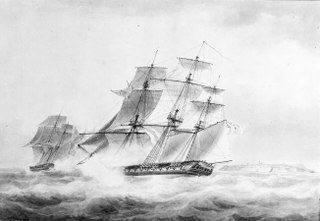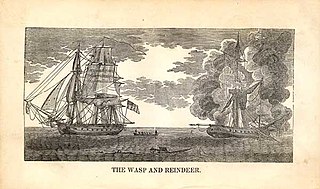
The Gunboat War was a naval conflict between Denmark–Norway and Great Britain supported by Sweden during the Napoleonic Wars. The war's name is derived from the Danish tactic of employing small gunboats against the materially superior Royal Navy. In Scandinavia it is seen as the later stage of the English Wars, whose commencement is accounted as the First Battle of Copenhagen in 1801.

HMS Phoenix was a 36-gun Perseverance-class fifth-rate frigate of the Royal Navy. The shipbuilder George Parsons built her at Bursledon and launched her on 15 July 1783. She served in the French Revolutionary and Napoleonic Wars and was instrumental in the events leading up to the battle of Trafalgar. Phoenix was involved in several single-ship actions, the most notable occurring on 10 August 1805 when she captured the French frigate Didon, which was more heavily armed than her. She was wrecked, without loss of life, off Smyrna in 1816.

HMS Reindeer was a Royal Navy 18-gun Cruizer-class brig-sloop of the Royal Navy, built by Samuel & Daniel Brent at Rotherhithe and was launched in 1804. She was built of fir, which made for more rapid construction at the expense of durability. Reindeer fought in the Napoleonic Wars before succumbing in 1814 to the guns of USS Wasp during the War of 1812.
HMS Landrail was a Cuckoo-class schooner built by Thomas Sutton at Ringmore, Teignmouth. Like all her class she carried four 12-pounder carronades and had a crew of 20. She had a relatively uneventful career during the Napoleonic Wars and the War of 1812 until 1814 when she was taken in a notable action, and then retaken. She was sold in approximately 1818.

HMS Primrose was a Royal Navy Cruizer-class brig-sloop built by Thomas Nickells, at Fowey and launched in 1807.
HMS Raven was a Cruizer-class brig-sloop built by Perry, Wells and Green at Blackwall Yard and launched in 1804. Although she embodied some interesting innovations tailored for service in the area of the Straits of Gibraltar, she was wrecked before she got on station and never tested them. Her captain, the innovator, was the subject of a miscarriage of justice at his court martial for the loss of the ship from which his career never recovered.
HMS Pike was a Royal Navy Ballahoo-class schooner of four 12-pounder carronades and a crew of 20. The prime contractor for the vessel was Goodrich & Co., in Bermuda, and she was launched in 1804. She captured one 10-gun enemy vessel before being herself captured, and recaptured.
HMS Snapper was a Royal Navy Ballahoo-class schooner of four 12-pounder carronades and a crew of 20. The prime contractor for the vessel was Goodrich & Co., in Bermuda, and she was launched in 1804. She cruised for some seven years, sharing in several captures of merchant vessels and taking some herself, before a French privateer captured her.
HMS Whiting was a Royal Navy Ballahoo-class schooner of four 12-pounder carronades and a crew of 20. The prime contractor for the vessel was Goodrich & Co., in Bermuda, and she was launched in 1805. She was a participant at the Battle of Basque Roads. A French privateer captured her at the beginning of the War of 1812, shortly after the Americans had captured and released her in the first naval incident of the war.

HMS Alacrity was a Cruizer-class brig-sloop built by William Rowe at Newcastle and launched in 1806. She served in the Baltic and was at the capture of Copenhagen in 1807. She captured a large privateer before herself falling victim to a French man-of-war in 1811 in an action in which her captain failed to distinguish himself. She then served in the French navy until she was broken up in 1822.
During the French Revolutionary and Napoleonic Wars the Admiralty also made use of hired armed vessels, one of which was His Majesty's Hired armed cutter Swan. Actually there were two such cutters, but the descriptions of these vessels and the dates of their service are such that they may well represent one vessel under successive contracts. The vessel or vessels cruised, blockaded, carried despatches and performed reconnaissance.

HMS Peterel was a 16-gun Pylades-class ship-sloop of the Royal Navy. She was launched in 1794 and was in active service until 1811. Her most famous action was the capture of the French brig Ligurienne when shortly after Peterel captured two merchant ships and sent them off with prize crews, three French ships attacked her. She drove two on shore and captured the largest, the 14-gun Ligurienne. The Navy converted Peterel to a receiving ship at Plymouth in 1811 and sold her in 1827.

HMS Peacock was a Cruizer-class brig-sloop of the Royal Navy. She was launched in 1806 and had a relatively uneventful career until she had the misfortune to encounter USS Hornet in February 1813. Hornet captured Peacock, which then sank.

HMS Grasshopper was a Cruizer-class brig-sloop of the Royal Navy. She was launched in 1806, captured several vessels, and took part in two notable actions before the Dutch captured her in 1811. She then served The Netherlands navy until she was broken up in 1822.
Two vessels have borne the designation, His Majesty's hired armed cutter Constitution. The first served the British Royal Navy during the French Revolutionary Wars. The second served briefly at the start of the Napoleonic Wars and was sunk in 1804. The two cutters are similar enough that may have been the same vessel; at this juncture it is impossible to know.
HMS Renard was a 12-gun schooner, previously the French navy schooner Renard. HMS Cameleon captured her in 1803 off Corsica and the Royal Navy took her into service under her existing name. The already being an HMS Renard, on the West Indies station, at some point between 1804 and 1807 the schooner's name was changed to HMS Crafty. During her brief service Renard/Crafty captured several merchantmen and a small armed vessel. In 1807 three Spanish privateers captured her.
The Royal Navy employed two vessels designated as His Majesty's Hired armed vessel Sir Thomas Pasley during the French Revolutionary Wars. The two vessels were named for Admiral Sir Thomas Pasley. The vessels are also sometimes described as cutters, but more generally as brigs. The Spanish captured the first Sir Thomas Pasley. The second had a brief, but highly productive, career that later led to her crew qualifying for the Naval General Service Medal. After she was returned to her owners in March 1802, she may have been wrecked in the Mediterranean that same year.
HMS Milbrook was one of six vessels built to an experimental design by Sir Samuel Bentham. After the Royal Navy took her into service in her decade-long career she took part in one notable single-ship action and captured several privateers and other vessels, all off the coast of Spain and Portugal. She was wrecked off the coast of Portugal in 1808.
HMS Experiment was launched in 1793, the only lugger actually designed and built for the British Royal Navy. The Spanish Navy captured her in 1796 near Gibraltar. A British privateer recaptured her in 1806, but the Royal Navy did not take her back into service.






